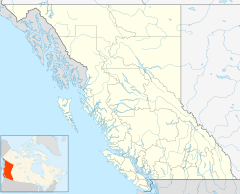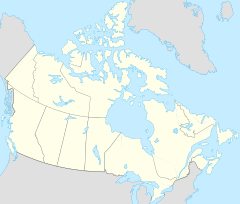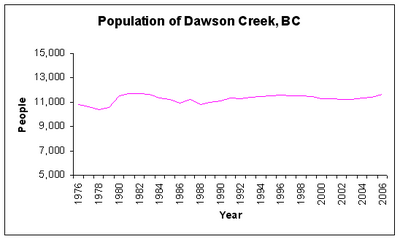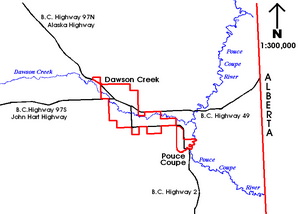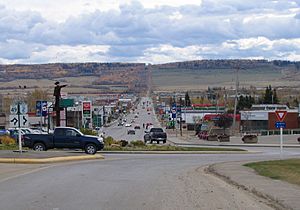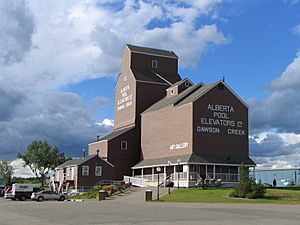Dawson Creek facts for kids
Quick facts for kids
Dawson Creek
|
|||
|---|---|---|---|
| The Corporation of the City of Dawson Creek | |||
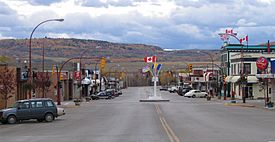
Looking south into downtown Dawson Creek, with the Mile "0" post.
|
|||
|
|||
| Country | Canada | ||
| Province | British Columbia | ||
| Region | Peace River | ||
| Incorporated | May 26, 1936 (village) January 6, 1958 (city) |
||
| Area | |||
| • City | 24.37 km2 (9.41 sq mi) | ||
| Elevation | 665 m (2,182 ft) | ||
| Population
(2016)
|
|||
| • City | 12,978 | ||
| • Density | 475.4/km2 (1,231/sq mi) | ||
| • Urban | 12,178 | ||
| • Urban density | 475.4/km2 (1,231/sq mi) | ||
| • Metro | 12,178 | ||
| • Metro density | 475.4/km2 (1,231/sq mi) | ||
| Time zone | UTC−07:00 (MST) | ||
| Forward sortation area |
V1G
|
||
| Area code(s) | 250, 778, 236, 672 | ||
| Highways |
|
||
Dawson Creek is a city in northeastern British Columbia, Canada. The municipality of 24.37 square kilometres (9.41 sq mi) had a population of 12,978 in 2016. Dawson Creek derives its name from the creek of the same name that runs through the community. The creek was named after George Mercer Dawson by a member of his land survey team when they passed through the area in August 1879. Once a small farming community, Dawson Creek became a regional centre after the western terminus of the Northern Alberta Railways was extended there in 1932. The community grew rapidly in 1942 as the US Army used the rail terminus as a transshipment point during construction of the Alaska Highway. In the 1950s, the city was connected to the interior of British Columbia via a highway and a railway through the Rocky Mountains. Since the 1960s, growth has slowed, but the area population has increased.
Dawson Creek is located in the dry and windy prairie land of the Peace River Country. As the seat of the Peace River Regional District and a service centre for the rural areas south of the Peace River, the city has been called the "Capital of the Peace". It is also known as the "Mile 0 City", referring to its location at the southern end of the Alaska Highway. It also has a heritage interpretation village, an art gallery, and a museum. Annual events include a fall fair and rodeo.
Contents
History
Dawson Creek is named after the watercourse of the same name, itself named after George Mercer Dawson who led a surveying team through the area in August 1879; a member of the team labelled the creek with Dawson's name. The community that formed by the creek was one of many farming communities established by European-Canadian settlers moving west through the Peace River Country. When the Canadian government began issuing homestead grants to settlers in 1912, the pace of migration increased. With the opening of a few stores and hotels in 1919 and the incorporation of the Dawson Creek Co-operative Union on 28 May 1921, Dawson Creek became a dominant business centre in the area. After much speculation by land owners and investors, the Northern Alberta Railways built its western terminus 3 km (2 mi) from Dawson Creek. The golden spike was driven on 29 December 1930, and the first passenger train arrived on 15 January 1931. The arrival of the railway and the construction of grain elevators attracted more settlers and business to the settlement. The need to provide services for the rapidly growing community led Dawson Creek to incorporate as a village in May 1936. A small wave of refugees from the Sudetenland settled in the area in 1939 as World War II was beginning. The community exceeded 500 people in 1941.
Upon entering the war, the United States decided to build a transportation corridor to connect the US mainland to Alaska. In 1942, thousands of US Army personnel, engineers, and contractors poured into the city – the terminal of rail transport – to construct the Alaska Highway. The highway was completed in less than a year; even after the workers involved in its construction departed, population and economic growth continued. In February 1943, a major fire and explosion in a livery barn, packed with road-building supplies including dynamite, caused serious damage to the center of town; five people were killed and 150 injured.
By 1951, Dawson Creek had more than 3,500 residents. In 1952, the John Hart Highway linked the town to the rest of the British Columbia Interior and Lower Mainland through the Rocky Mountains; a new southbound route, known locally as Tupper Highway, made the town a crossroads with neighbouring Alberta. The next year, western Canada's largest propane gas plant was built and federal government offices were established in town. In 1958, the extension of the Pacific Great Eastern Railway to the Peace from Prince George was completed, and the village was re-incorporated as a city. Between 1951 and 1961, the population of Dawson Creek more than tripled.
Growth slowed in the 1960s, with the population reaching its all-time high in 1966. In the 1970s, the provincial government moved its regional offices from Pouce Coupe to the city, Northern Lights College opened a Dawson Creek campus, and the Dawson Creek Mall was constructed. Several modern grain elevators were built, and the town's five wooden grain elevators, nicknamed "Elevator Row", were taken out of service. Only one of the historic elevators remains, converted to an art gallery. Since the 1970s, with the nearby town of Fort St. John attracting much of the area's industrial development and Grande Prairie becoming a commercial hub, the town's population and economy have not significantly increased.
Since 1992, the city has undergone several boundary expansions. One expansion incorporated undeveloped land in the southeast for an industrial park and a Louisiana-Pacific Canada veneer factory. The city extended sewer and water lines to the location; however, the area was not developed and with the factory only half-built, L-P Canada abandoned its plans. A business making manufactured homes bought the factory and completed its development in 2005. Another expansion incorporated the existing oriented strand board factory in the northwest corner of the city, while further incorporations have included undeveloped land to the south and north.
Demographics
| Historical population | ||
|---|---|---|
| Year | Pop. | ±% |
| 1941 | 518 | — |
| 1951 | 3,589 | +592.9% |
| 1961 | 10,946 | +205.0% |
| 1981 | 11,373 | +3.9% |
| 1991 | 10,981 | −3.4% |
| 1996 | 11,125 | +1.3% |
| 2001 | 10,754 | −3.3% |
| 2006 | 10,994 | +2.2% |
| 2011 | 11,583 | +5.4% |
| 2016 | 12,178 | +5.1% |
In the 2021 Census of Population conducted by Statistics Canada, Dawson Creek had a population of 12,323 living in 5,405 of its 6,189 total private dwellings, a change of 1.2% from its 2016 population of 12,178. With a land area of 26.72 km2 (10.32 sq mi), it had a population density of 461.2/km2 (1,195/sq mi) in 2021.
The 1941 census, the first to include Dawson Creek as a defined subdivision, counted 518 residents. Its growth spurred by the construction of the Alaska Highway, the town recorded a sevenfold increase to 3,589 residents in the 1951 census. Within five years, the population more than doubled to 7,531. New transport links with southern British Columbia and Alberta spurred continued growth into the next decade. The population peaked in 1966 at 12,392, then declined throughout the 1970s, rising again briefly during the construction of the nearby town of Tumbler Ridge in the early 1980s. Dawson Creek's population has remained relatively stable since then. Between 2005 and 2009, the population rose from 10,869 to 11,514, per provincial estimates.
| Canada 2016 Census | ||
| Dawson Creek | British Columbia | |
| Median age | 34 years | 43 years |
| Under 15 years old | 19% | 15% |
| Over 65 years old | 13% | 18% |
| Visible minority | 10% | 30% |
According to the 2016 Canadian census, there was an average household size of 2.3 persons, similar to the provincial average of 2.4 persons. One-person households made up 32% of total households, slightly above the 29% average provincewide, leaving the average family size to be 2.9 persons. The median age decreased from 38.8 years in 2001 to 34.4 in 2016 with 53% of those over 15 years of age being married (or common law), lower than the 58% provincial average. Nearly 16% of the city's population belong to an Aboriginal group (Métis or First Nations) with an additional 10% belonging to a Visible minority group (primarily Filipino and South Asian). Only 46% of residents over 15 years old had a post-secondary certificate (including degree, diploma and trades certificate), compared to the provincewide rate of 55%. Among those aged 25–64, 17% did not have a high school certificate or equivalent, higher than the 10% provincewide rate.
Geography and climate
At the foot of Bear Mountain ridge, the city developed around the Dawson Creek watercourse which flows eastward into the Pouce Coupe River. The city is located on the Pouce Coupe Prairie in the southwestern part of the Peace River Country, 72 km (44.7 mi) southeast of Fort St. John, and 134 km (83.3 mi) northwest of Grande Prairie, Alberta. According to the Canada Land Inventory, the city is on soil that has moderate limitations, due to an adverse climate, that restrict the range of crops or require moderate conservation practices. The land is flat, but slopes upwards in the northeastern corner elevating a residential area over the rest of the city.
The city is in the British Columbia Peace Lowland ecosection of the Canadian Boreal Plains ecozone on the continental Interior Platform. Located in the Cordillera Climatic Region, it lies at the southern end of a subarctic climate (Köppen Dfc). In the summer, the city is often dusty and arid; temperatures during the day are warm, but cool at night, typically falling below 10 °C (50 °F). Highs reaching 30 °C (86 °F) occur only twice per year on average. Heavy rain showers are sporadic, lasting only a few minutes. In the winter, the city can get bitterly cold and dry, with 17 to 18 days of −30 °C (−22 °F) lows per year. It is subject to very strong winds year round. Unlike most of the province, the city and its region use Mountain Standard Time (UTC−07:00) all year round, since the area already has long daylight hours in the summer and short daylight hours in the winter. In other words, residents of the region never change their clocks - they use Pacific Daylight Time during the spring and summer, and Mountain Standard Time during the fall and winter.
| Climate data for Dawson Creek Airport | |||||||||||||
|---|---|---|---|---|---|---|---|---|---|---|---|---|---|
| Month | Jan | Feb | Mar | Apr | May | Jun | Jul | Aug | Sep | Oct | Nov | Dec | Year |
| Record high humidex | 16.3 | 14.7 | 18.1 | 28.9 | 31.6 | 33.8 | 39.2 | 36.3 | 33.8 | 27.4 | 19.7 | 12.9 | 39.2 |
| Record high °C (°F) | 16.6 (61.9) |
15.5 (59.9) |
18.9 (66.0) |
29 (84) |
32.2 (90.0) |
33.3 (91.9) |
35 (95) |
34.5 (94.1) |
32 (90) |
27.5 (81.5) |
18.9 (66.0) |
13.8 (56.8) |
35 (95) |
| Average high °C (°F) | −7.1 (19.2) |
−3.9 (25.0) |
0.9 (33.6) |
10 (50) |
16.4 (61.5) |
20.1 (68.2) |
22.2 (72.0) |
21.5 (70.7) |
16.2 (61.2) |
9 (48) |
−1.5 (29.3) |
−5.3 (22.5) |
8.2 (46.8) |
| Daily mean °C (°F) | −13.2 (8.2) |
−10.2 (13.6) |
−5 (23) |
3.5 (38.3) |
9.3 (48.7) |
13.6 (56.5) |
15.5 (59.9) |
14.4 (57.9) |
9.8 (49.6) |
3.3 (37.9) |
−6.8 (19.8) |
−11.1 (12.0) |
1.9 (35.4) |
| Average low °C (°F) | −19 (−2) |
−16.5 (2.3) |
−10.9 (12.4) |
−3.1 (26.4) |
2.1 (35.8) |
6.9 (44.4) |
8.9 (48.0) |
7.2 (45.0) |
3.3 (37.9) |
−2.4 (27.7) |
−12.2 (10.0) |
−16.8 (1.8) |
−4.4 (24.1) |
| Record low °C (°F) | −48.3 (−54.9) |
−45 (−49) |
−44.4 (−47.9) |
−31.4 (−24.5) |
−13.8 (7.2) |
−5 (23) |
−1.7 (28.9) |
−7.1 (19.2) |
−16.7 (1.9) |
−30.9 (−23.6) |
−39.8 (−39.6) |
−49.2 (−56.6) |
−49.2 (−56.6) |
| Record low wind chill | −57.5 | −53.2 | −51.1 | −33.5 | −16.6 | −7.4 | 0 | −5.4 | −15.3 | −37.6 | −55.4 | −54.5 | −57.5 |
| Average precipitation mm (inches) | 29.1 (1.15) |
18.6 (0.73) |
22.6 (0.89) |
19.8 (0.78) |
34.4 (1.35) |
67.4 (2.65) |
84.9 (3.34) |
54.2 (2.13) |
41.2 (1.62) |
29.9 (1.18) |
29 (1.1) |
22.2 (0.87) |
453.2 (17.84) |
| Average rainfall mm (inches) | 0.8 (0.03) |
0.4 (0.02) |
0.6 (0.02) |
9.4 (0.37) |
29.8 (1.17) |
67.4 (2.65) |
84.9 (3.34) |
54.2 (2.13) |
38.8 (1.53) |
15.9 (0.63) |
4.2 (0.17) |
0.8 (0.03) |
307.2 (12.09) |
| Average snowfall cm (inches) | 34.2 (13.5) |
22.8 (9.0) |
26.6 (10.5) |
11.2 (4.4) |
5.1 (2.0) |
0 (0) |
0 (0) |
0 (0) |
2.4 (0.9) |
15.2 (6.0) |
29.1 (11.5) |
26 (10) |
172.7 (68.0) |
| Average precipitation days (≥ 0.2 mm) | 10.9 | 9.1 | 8.9 | 7.2 | 10.5 | 11.8 | 14.4 | 12.1 | 11.2 | 10.2 | 11 | 9.2 | 126.4 |
| Average rainy days (≥ 0.2 mm) | 0.8 | 0.4 | 0.8 | 4 | 9.7 | 11.8 | 14.4 | 12.1 | 10.5 | 6.7 | 2.3 | 0.6 | 73.9 |
| Average snowy days (≥ 0.2 cm) | 10.9 | 9.2 | 8.5 | 4 | 1.4 | 0 | 0 | 0 | 0.9 | 4.5 | 9.3 | 9 | 57.8 |
| Average relative humidity (%) (at 3pm) | 65.6 | 61.3 | 54.7 | 42.2 | 39 | 43.5 | 47.5 | 47.3 | 48.6 | 52.3 | 66 | 67.9 | 53 |
Transportation and infrastructure
Dawson Creek's road network was laid out in the mid-20th century as the town rapidly expanded. The city maintains 88 km (55 mi) of paved and 11 km (7 mi) of unpaved roads. The primary roads generally follow a grid pattern around large blocks of land. Because the grid contains many internal intersections with stop signs, traffic is forced onto two arterial roads: 8 Street going north–south and Alaska Avenue going southeast–northwest. These two roads meet at a traffic circle where a metal statue marks the beginning of the Alaska Highway, and the Mile Zero Post is now located. Officially designated British Columbia Highway 97, it runs north from Dawson Creek to Fort St. John and the Yukon – where it becomes Highway 1 – before reaching Alaska. The other highways emanating from Dawson Creek are the John Hart Highway, also 97 (southwest to Chetwynd and Prince George), Highway 2 (south to Grande Prairie and southern Alberta), and Highway 49 (east to Peace River and northern Alberta). A road with few intersections along the southern and western borders of the city, incorporating a stretch of Highway 2, is designated as a "dangerous goods route" for heavy trucks so that they can avoid traveling through the city. However, Highway 49 has no direct access to such a ring road, so many trucks bound to or from the east use the city arterials, slowing traffic and damaging roads.
Dawson Creek is a regional node for air and rail services. The Dawson Creek Airport, which services commercial flights by Central Mountain Air, was built in 1963; its 1,524 m (5,000 ft) runway was paved in 1966. There are larger airports in Fort St. John and Grande Prairie that maintain more comprehensive flight schedules. Passenger rail service was available in Dawson Creek between 1931 and 1974. Service began when the Northern Alberta Railways (NAR) built its northwest terminus in the town and was extended in 1958 to Vancouver with a rail line through the Rocky Mountains. Passenger rail service ended as commodity shipments of grains, oil and gas by-products, and forestry products became more important in the resource-based economy.
The city draws its water supply from the Kiskatinaw River, 18 km (11 mi) west of town. Before reaching the city, the water is pumped through a settling pond, two storage ponds, and a treatment plant where it is flocculated, filtered, and chlorinated. The city also provides drinking water for Pouce Coupe and rural residents. Sewage is processed by a lagoon system east of town and released into the Pouce Coupe River.
Culture and recreation
The cultural identity of Dawson Creek rests on its designation as Mile "0" of the Alaska Highway. The Mile "0" post, depicted in the city flag, is located in the historic downtown area, one block south of the Northern Alberta Railways Park. This four-acre (1.6 ha), mostly paved park is the gathering point for travellers. The park includes the Dawson Creek Art Gallery, which exhibits work by local artists and craftsmen. The Station Museum, connected to the art gallery, displays artifacts and exhibits associated with the construction of the NAR railway and the Alaska Highway. Other parks in Dawson Creek include the Mile Zero Rotary Park and the Walter Wright Pioneer Village. Annual events in the city include the Dawson Creek Symphonette and Choir performance, the Dawson Creek Art Gallery auction, the Dawson Creek Spring Rodeo, and the Peace Country Blue Grass Festival. The largest event, held annually since 1953, is the Dawson Creek Fall Fair & Exhibition — a five-day professional rodeo, with a parade, fairgrounds, and exhibitions.
City recreation facilities include two ice hockey arenas, a curling rink, an indoor swimming pool, an outdoor ice rink, and a speed skating oval. The South Peace Community Multiplex, a new facility completed in 2010, boasts a pool, indoor rodeo grounds and ice rink. Voters approved building the Multiplex in a 2004 referendum which projected its cost at C$21.6 million. The project became controversial when construction began and the cost projection was raised to $35 million. The facility is located close to the city's exhibition grounds, away from residential uses. It features an indoor rodeo arena and a 4,000-seat convention centre/ice arena with skyboxes. Nearby Bear Mountain, located south of the city, provides over 20 km (12 mi) of snowshoeing and cross-country skiing trails, as well as areas for downhill skiing and about 500 km (300 mi) of trails for snowmobiles, mountain bikes, and all-terrain vehicles. The city was once home to a North American Hockey League team, the Dawson Creek Rage, beginning in the 2010–11 season until it ceased operations in 2012 due to financial difficulties.
Economy
| Economy (2001) | ||
|---|---|---|
| Rate | City | Province |
| Unemployment rate | 10.3% | 8.5% |
| Participation rate | 69.5% | 65.2% |
| Poverty rate | 16.5% | 17.8% |
| Average male income | $49,551 | $50,191 |
| Average female income | $30,846 | $35,895 |
The economy of Dawson Creek is based on four major industries: agriculture, retail, tourism, and oil and gas. Agriculture has historically been the most important industry to Dawson Creek, as the city is the regional transshipment point for agricultural commodities. The city is surrounded by the Agricultural Land Reserve, where the soil can support livestock and produces consistently good yields of quality grain and grass crops, such as canola, hay, oats, alfalfa, wheat, and sweet clover. The service and retail sector caters to the city's inhabitants, smaller nearby towns, and rural communities. However, there is significant retail leakage to Grande Prairie, the closest major Alberta city, where there is no provincial tax on retail purchases, while British Columbia charges 7%. In 2006, the BC government rejected a proposal to lower the sales tax in the province's border communities to 4%. The problem of leakage has been exacerbated in recent years by the introduction of large-format retail stores into the small city. Residents still cross the border for high-priced items but now also purchase medium- and low-priced items from foreign-owned large-format chain stores.
Dawson Creek has a large tourism industry as Mile "0" of the Alaska Highway. Thousands of people drive on the highway every year, starting in Dawson Creek and ending in Fairbanks, Alaska. The trek is often made with recreational vehicles, sometimes in convoys which gather in the city. In the winter, the hospitality industry caters to workers from the oil patches. Discoveries south of Dawson Creek and higher energy prices have spurred oil and gas activities, which have in turn driven the nearby Fort St. John economy to spill over to the Dawson Creek economy. British Columbia's first wind farm, Bear Mountain Wind Park, was constructed southwest of the city in 2009.
Education
Dawson Creek is located in School District 59 Peace River South which maintains four elementary schools (Tremblay, Frank Ross, Crescent Park, and Canalta elementary schools), and one high school (Dawson Creek Secondary School).
Mountain Christian School, and Ron Pettigrew Christian School are K-12 private schools located in the city. There is also Notre Dame which is a K-7 Catholic school.
Established in 1975, Northern Lights College has a campus in Dawson Creek that houses its Regional Administration and two Centres of Excellence. At Northern Lights College, students can earn a one-year certificate, a two-year diploma or associate degree, or complete upgrading courses to get their high school diploma.
Notable people
- Dan Brennan, ice hockey player
- Roy Forbes, singer-songwriter
- Ben Heppner, opera singer / tenor
- Phil Sykes, ice hockey player
See also
 In Spanish: Dawson Creek para niños
In Spanish: Dawson Creek para niños



